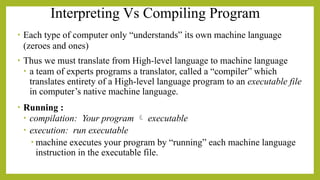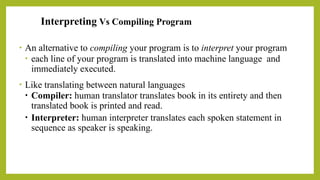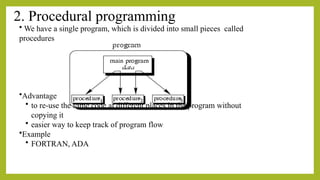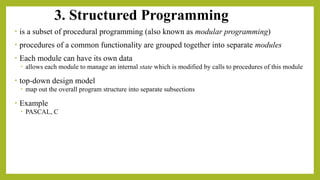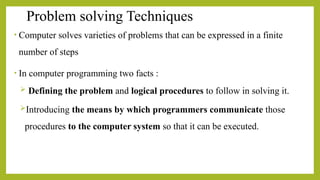chapter _3.pptx Programming Language in DSS
- 2. ’éŚ Programing language is an artificial language that can be used to control the behavior of a computer. ’éŚ defined by: ’éŚSyntactic - describes the possible combinations of symbols that form a syntactically correct program. ’éŚSemantic - is a combination of symbols. ’éŚ computers do exactly what they are told to do. ’éŚ Programming languages can be divided in to two major categories: ’āślow-level languages ’āśhigh-level languages
- 3. ’éŚ Machine language ’éŚ machine is short for computing machine (i.e., computer) ’éŚ computerŌĆÖs native language, sequence of zeroes and ones (binary) ’éŚ different computers understand different sequences ’éŚ hard for humans to understand: 01010001ŌĆ” ’éŚ Assembly language ’éŚ memonics for machine language ’éŚ low level: each instruction is minimal ’éŚ still hard for humans to understand: ’āśHigh-level languages ’éŚ FORTRAN, Pascal, BASIC, C, C++, Java, COBOL, etc. ’éŚ high level: each instruction composed of many low-level instructions.
- 4. Interpreting Vs Compiling Program ŌĆó Each type of computer only ŌĆ£understandsŌĆØ its own machine language (zeroes and ones) ŌĆó Thus we must translate from High-level language to machine language ŌĆó a team of experts programs a translator, called a ŌĆ£compilerŌĆØ which translates entirety of a High-level language program to an executable file in computerŌĆÖs native machine language. ŌĆó Running : ŌĆó compilation: Your program ’āĀ executable ŌĆó execution: run executable ŌĆó machine executes your program by ŌĆ£runningŌĆØ each machine language instruction in the executable file.
- 5. Interpreting Vs Compiling Program ŌĆó An alternative to compiling your program is to interpret your program ŌĆó each line of your program is translated into machine language and immediately executed. ŌĆó Like translating between natural languages ŌĆó Compiler: human translator translates book in its entirety and then translated book is printed and read. ŌĆó Interpreter: human interpreter translates each spoken statement in sequence as speaker is speaking.
- 6. Programming paradigm ’éŚ A programming paradigm is a fundamental style of programming ’éŚ Unstructured Programming ’éŚ Procedural programming . ’éŚ Structured Programming ’éŚ Object Oriented Programming
- 7. 1. Unstructured Programming ŌĆó consisting only of one large (usually main) program ŌĆó ŌĆ£main programŌĆØ' stands for a sequence of commands or statements ŌĆó data is global throughout the whole program ŌĆó disadvantages ŌĆó Complex ŌĆó if the same statement sequence is needed at different locations within the program, the sequence must be copied
- 8. 2. Procedural programming ’éŚ based upon the concept of procedure call ’éŚ A procedure call is used to invoke the procedure ’éŚ Procedures (routines, subroutines, methods, functions) simply contain a series of computational steps to be carried out to solve a problem
- 9. 2. Procedural programming ŌĆó We have a single program, which is divided into small pieces called procedures ŌĆóAdvantage ŌĆó to re-use the same code at different places in the program without copying it ŌĆó easier way to keep track of program flow ŌĆóExample ŌĆó FORTRAN, ADA
- 10. 3. Structured Programming ŌĆó is a subset of procedural programming (also known as modular programming) ŌĆó procedures of a common functionality are grouped together into separate modules ŌĆó Each module can have its own data ŌĆó allows each module to manage an internal state which is modified by calls to procedures of this module ŌĆó top-down design model ŌĆó map out the overall program structure into separate subsections ŌĆó Example ŌĆó PASCAL, C
- 11. 3.Structured Programming ŌĆó Advantage ŌĆó Reuse ŌĆó Easier to understand and modify
- 12. 4. Object Oriented Programming ŌĆó Is a method of implementation in which programs are organized as cooperative collections of objects ŌĆó Data and operations are grouped together ŌĆó Each object is capable of receiving messages, processing data, and sending messages to other objects ŌĆó Modeling of the domain as objects so that the implementation naturally reflects the problem at hand.
- 13. Problem solving Techniques ŌĆó Computer solves varieties of problems that can be expressed in a finite number of steps ŌĆó In computer programming two facts : ’āś Defining the problem and logical procedures to follow in solving it. ’āśIntroducing the means by which programmers communicate those procedures to the computer system so that it can be executed.
- 14. Problem solving Techniques ŌĆó There are system analysis and design tools, particularly flowchart and structure chart, that can be used to define the problem in terms of the steps to its solution. ŌĆó The programmer uses programming language to communicate the logic of the solution to the computer. ŌĆó An algorithm is defined as a step-by-step sequence of instructions that must terminate and describe how the data is to be processed to produce the desired outputs. ŌĆó Simply, algorithm is a sequence of instructions
- 15. System Development Life Cycle(SDLC) ŌĆó is a conceptual model used in project management that describes the stages involved in a computer system development project from an initial feasibility study through maintenance of the completed application.
- 16. System Development Life Cycle(SDLC) ŌĆó The phases of SDLC are : ŌĆó Feasibility study ŌĆó Requirements analysis ŌĆó Designing solution ŌĆó Testing designed solution ŌĆó Testing ŌĆó Implementation
- 17. System Development Life Cycle ŌĆó Feasibility study : The first step is to identify a need for the new system. a. Organizational Feasibility ŌĆó How well the proposed system supports the strategic objectives of the organization. b. Economic Feasibility ŌĆó Cost savings ŌĆó Increased revenue ŌĆó Decreased investment ŌĆó Increased profits
- 18. System Development Life Cycle c. Technical Feasibility ŌĆó Hardware, software, and network capability, reliability, and availability d. Operational Feasibility ŌĆó End user acceptance ŌĆó Management support ŌĆó Customer, supplier, and government requirements
- 19. System Development Life Cycle Requirements analysis : is the process of analyzing the information needs of the end users, the organizational environment, and any system presently being used, developing the functional requirements of a system that can meet the needs of the users.
- 20. System Development Life Cycle Designing solution: ŌĆó After the requirements have been determined, the necessary specifications for the hardware, software, people, and data resources, and the information products that will satisfy the functional requirements of the proposed system can be determined. ŌĆó The design will serve as a blueprint for the system and helps detect problems before these errors or problems are built into the final system.
- 21. System Development Life Cycle Implementation ŌĆó The real code is written here. Systems implementation is the construction of the new system and its delivery into production or day-to-day operation.
- 22. System Development Life Cycle Testing ŌĆó Unit Testing ŌĆó Integrating Testing ŌĆó System Testing Maintenance ŌĆó What happens during the rest of the software's life: changes, correction, additions, and moves to a different computing platform and more. ŌĆó This, the least exciting and perhaps most important step of all, goes on seemingly forever.



